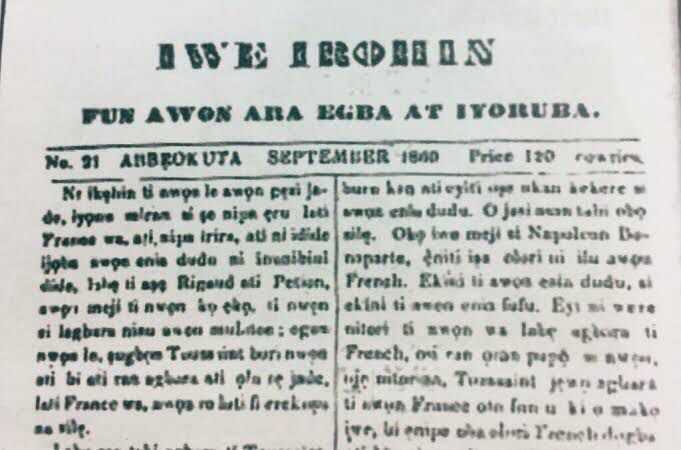
Iwe Irohin, Nigeria’s First Newspaper
Before the establishment of popular news outlets in Nigeria like Vanguard newspaper, The Guardian newspaper, Daily Post newspaper, Punch newspaper and many more; Iwe Irohin, the first newspaper in Nigeria paved the way for the mainstream ones.
The history of print media in Nigeria dates back to the 1840s when the European Christian mission were seeking ways to propagate the gospel in West Africa. In 1800, there were no newspapers in West Africa until the mid 19th century.
“Iwe Irohin fun awon ara Egba ati Yoruba” was written in both Yoruba and English Language. It was the first newspaper in Nigeria to be established in November 23, 1859 for the Egba people of Abeokuta and the rest of Yoruba land. It was founded by a missionary from Exeter, England – Rev. Henry Townsend. The newspaper was initially published in the indigenous Yoruba language and was later supplemented with the English language from March 8, 1860.
Read Also: Benue State: The Food Basket of the Nation
You may wonder why Iwe Irohin was established. The main purpose of establishing Iwe Irohin was for the propagation of the gospel (Anglican faith of Christianity) to the Egba people of Abeokuta, and across Yoruba land, and also to encourage and assist them to read and write. It however came to an end eight years after in 1867.
The Newspaper made its debut on December 3, 1859 and was published fortnightly (every two weeks) with a single edition having about eight pages. It was sold for 120 cowries. The newspaper was highly patronised by the few literates living in Abeokuta at the time with access to the newspaper publications, and this brought about a circulation of 3000 copies.
Iwe Irohin was considered a religious newspaper as it was under the direction of a Christian Missionary Society (C.M.S) Missionary of the Anglican Church. James Ede, who was trained and appointed by Henry Townsend, was the chief printer of the newspaper. Before the advancement in technology, Iwe Irohin was printed with crude technology which existed at the time and was devoid of graphics and pictures with pages divided in two columns.
Although, Iwe Irohin widened its content by publishing articles which did not only border on the gospel, like stories about Abeokuta, Cocoa statistics, cotton; the onlookers narrowly understood the newspaper to be of only religious publications. However, in 1863, the C.M.S authorities perceived the content of Iwe Irohin to be literary hostile to the colonial government and therefore cautioned the publications. Despite this posing as an inhibition, it did not stop the publishing and sale of the newspaper.
Iwe Irohin, which set the path to the conveyance of information through print media contributed widely to Nigerian journalism. The newspaper also embraced and encouraged the abolition of slavery as it was highly contradictory to the gospel mission. Iwe Irohin brought Nigeria’s Samuel Ajayi Crowther, who assisted in translating the Bible and Hymn to Yoruba language into the limelight. The newspaper also helped the people of Abeokuta stay informed on political/general developments happening around them. Additionally, its short existence greatly paved the way for the establishment of leading newspaper companies in Nigeria.
